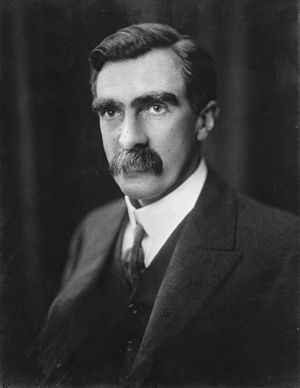Kerr Grant facts for kids
Quick facts for kids
Sir Kerr Grant
|
|
|---|---|

Kerr Grant
|
|
| Born | 26 June 1878 |
| Died | 13 October 1967 (aged 89) Adelaide, Australia
|
| Nationality | |
| Alma mater | University of Melbourne |
| Scientific career | |
| Institutions | University of Adelaide |
| Doctoral advisor | Thomas Ranken Lyle |
| Doctoral students | William O. Gibberd |
Sir Kerr Grant was an important Australian physicist. He was also a key person in running universities and colleges in South Australia. This was during the first half of the 1900s.
Early Life and Education
Kerr Grant was born in 1878. His hometown was Bacchus Marsh, a small town near Melbourne. This town is in the Australian state of Victoria.
He loved mathematics and studied it at the University of Melbourne. He earned two degrees there. He got his first degree (BSc) in 1901. His second degree (MSc) followed in 1903. Both were with top honors.
In 1904, he traveled to Germany. He studied at the University of Göttingen. There, he worked with Irving Langmuir. Langmuir was an American Nobel Prize winner in chemistry and physics.
A Career in Physics
In 1911, Kerr Grant became a professor at the University of Adelaide. He was the Elder Professor of Physics. He held this important job until 1948.
Many of his students became famous scientists. These included Dr. Douglas Allen, who worked on atomic research. Another was Professor George Eric MacDonnell Jauncey. He became a physics professor in the United States. Other notable students were Hugh Cairns, Mark Oliphant, and Howard Florey. Howard Florey later became Baron Florey.
In 1919, he visited the General Electric Co. labs. These labs were in Schenectady, United States. He was very interested in their work on tiny molecular films. When he returned to Adelaide, he encouraged others to study these films. He especially looked at films on mercury.
Helping During Wartime
During World War II, many scientists helped their countries. Kerr Grant was one of them. He worked on several important projects.
He led a committee about scientific workers in physics. He also managed the Army Inventions Directorate in Adelaide. He was a member of the Optical Munitions Panel. This group helped make optical parts for weapons. He also joined a sub-committee for chemical defense.
Later Life and Legacy
Kerr Grant did not think he was a brilliant physicist. But his work during the war was very important. His teaching and leadership also made a big difference. Because of this, he received a knighthood in 1947. This meant he was given the title "Sir."
He also helped make science popular. He wrote a newspaper column. In it, he answered science questions from readers. Some people saw him as a classic "absent-minded professor." He really enjoyed this idea.
He was very well-liked at the University of Adelaide. His students often played practical jokes on him. He always played along cheerfully. Many jokes involved his old 1929 car. He refused to get rid of it!
In 1948, he retired. His final lecture was a huge event. About 700 past and present students came to see him. It was a very lively and fun farewell. It was one of the biggest "rags" (student celebrations) for a professor in the university's history.
Sir Kerr Grant passed away in 1967. He had a broken hip and then got pneumonia. A street in Adelaide is named after him. It is called Kerr Grant Terrace. Lecture halls at two universities in Adelaide are also named in his honor.

